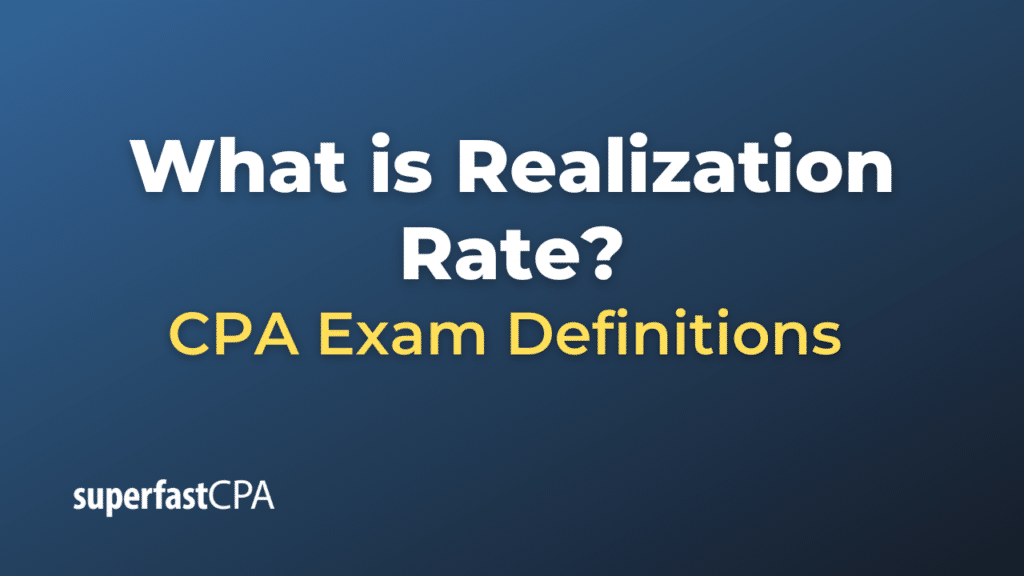Realization Rate
The realization rate is a metric commonly used in professional service industries, particularly in law firms, consulting firms, and accounting firms. It measures the percentage of billable hours (or standard rates) that is actually invoiced and subsequently collected from clients. In essence, the realization rate gives insight into how much of the work done (or value provided) is transformed into actual revenue.
Mathematically, the realization rate can be expressed as:
Realization Rate = (Amount Billed to Client / Billable Hours × Standard Hourly Rate) × 100%
or, if you’re focusing on collections:
Realization Rate = (Amount Collected from Client / Billable Hours × Standard Hourly Rate) × 100%
For instance, if an attorney charges $200 per hour as a standard rate and works 10 hours on a client’s case, the total billable amount is $2,000. However, if the attorney ends up billing the client only $1,800 (perhaps due to negotiations, discounts, or other adjustments), the realization rate is:
Realization Rate = $1,800 / $2,000 x 100% = 90%
A realization rate of 100% would mean that the firm billed and collected exactly what it initially intended based on its standard rates. Rates below 100% can indicate discounts, write-offs, or uncollected amounts, while rates above 100% might indicate that the firm was able to bill more than initially expected (which can occasionally happen, especially if a project took less time than anticipated but was billed at a fixed rate).
The realization rate is a crucial metric for service firms as it provides insight into billing efficiency, pricing strategies, client negotiations, and overall financial health. If a firm consistently has a low realization rate, it might indicate that the firm’s standard rates are too high, there are frequent billing disputes with clients, or that there’s inefficiency in the billing or collection process.
Example of Realization Rate
Let’s explore the realization rate with a detailed scenario involving a consulting firm:
Imagine “StratConsult,” a consulting firm that offers business strategy services. StratConsult has a standard hourly rate of $150 for its consultants.
Jane, a consultant at StratConsult, works on a project for “TechNova,” a tech startup. Over the course of a week, she logs 40 billable hours for this project. Based on the standard rate, the total expected billing amount is:
40 hours x $150/hour = $6,000
However, considering TechNova is a startup and is looking for a discount, StratConsult agrees to give them a 10% discount on the total bill. This means the actual billed amount is:
$6,000 – 10% x $6,000 = $5,400
A month later, when StratConsult is reconciling its accounts, they realize that TechNova has disputed $400 of the billed amount due to a perceived discrepancy in hours logged. StratConsult reviews the claim and agrees to adjust the billing, which results in the final collected amount being:
$5,400 – $400 = $5,000
Calculating the Realization Rate:
- Based on Billed Amount:
Realization Rate (billed) = (Amount Billed to Client / Billable Hours × Standard Hourly Rate) × 100%
Realization Rate (billed) = $5,400 / $6,000 x 100% = 90%
- Based on Collected Amount:
Realization Rate (collected) = (Amount Collected from Client / Billable Hours × Standard Hourly Rate) × 100%
Realization Rate (collected) = $5,000 / $6,000 x 100% = 83.33%
The billed realization rate of 90% indicates that StratConsult billed 90% of what it initially expected based on its standard rates. The collected realization rate of 83.33% reveals that, after all adjustments and disputes, StratConsult managed to collect just over 83% of what was expected based on the standard hourly rate.
If StratConsult experiences such rates consistently across many clients, it might prompt them to review their billing practices, client negotiations, and dispute resolution processes. It also provides valuable feedback on pricing strategies and the firm’s overall financial efficiency.













